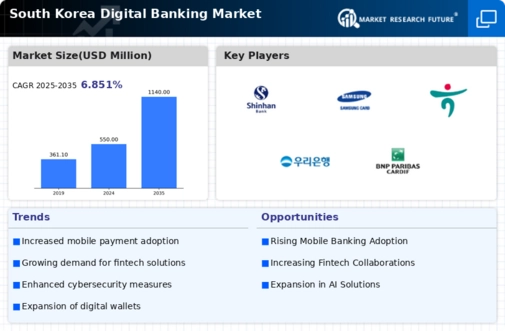Increased Internet Penetration
The digital banking market in South Korea is significantly influenced by the high rate of internet penetration. As of November 2025, approximately 98% of the population has access to the internet, facilitating the widespread adoption of digital banking services. This connectivity allows consumers to engage with their banks anytime and anywhere, leading to a shift in banking habits. The convenience offered by online banking platforms is likely to drive more users towards digital solutions. Moreover, the increasing use of smartphones, with over 90% of the population owning one, further supports this trend. The combination of high internet access and smartphone usage creates a favorable environment for the digital banking market to thrive.
Consumer Demand for Convenience
The digital banking market in South Korea is propelled by a growing consumer demand for convenience and efficiency. As lifestyles become increasingly fast-paced, individuals seek banking solutions that save time and effort. Digital banking platforms offer features such as instant fund transfers, online loan applications, and 24/7 access to account information. This demand for convenience is reflected in the rising number of users engaging with digital banking services, which has seen an increase of 25% over the past year. Additionally, the integration of various financial services into a single platform enhances user experience, making digital banking more appealing. As consumers continue to prioritize convenience, the digital banking market is likely to expand further.
Regulatory Support and Frameworks
The digital banking market in South Korea benefits from a supportive regulatory environment. The government has implemented various policies aimed at fostering innovation and competition within the financial sector. For example, the Financial Services Commission (FSC) has introduced guidelines that encourage the establishment of digital-only banks. This regulatory support is crucial as it not only promotes the entry of new players but also enhances consumer trust in digital banking services. As of 2025, the number of licensed digital banks in South Korea has increased significantly, indicating a robust market landscape. Furthermore, the regulatory frameworks are designed to ensure consumer protection, which is vital for the growth of the digital banking market.
Competitive Landscape and Innovation
The digital banking market in South Korea is characterized by a highly competitive landscape, which drives innovation among financial institutions. Established banks are increasingly investing in digital transformation to retain their customer base and attract new clients. This competition has led to the development of innovative products and services, such as mobile payment solutions and personalized financial management tools. As of November 2025, the market has seen a surge in partnerships between traditional banks and fintech companies, fostering a collaborative environment that enhances service offerings. The competitive dynamics are expected to continue evolving, pushing banks to adopt cutting-edge technologies and improve customer engagement strategies, thereby benefiting the overall digital banking market.
Technological Advancements in Banking
The digital banking market in South Korea is experiencing rapid growth due to technological advancements. Innovations such as artificial intelligence (AI), machine learning, and blockchain technology are transforming traditional banking practices. These technologies enhance operational efficiency and improve customer experience. For instance, AI-driven chatbots are increasingly used for customer service, providing 24/7 assistance. According to recent data, the adoption of AI in banking is projected to increase by 30% in the next few years. This shift towards technology-driven solutions is likely to attract a younger demographic, which is essential for the sustainability of the digital banking market. As banks invest in these technologies, they are expected to offer more personalized services, thereby increasing customer satisfaction and loyalty.
















Leave a Comment